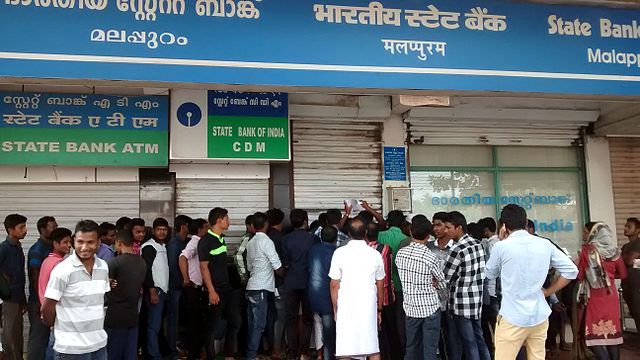
While all eyes were trained on the presidential elections in the US, the Indian Prime Minister, Narendra Modi, made a surprise television announcement on 8 November: all 500 and 1,000 rupee notes (worth some €7 and €14, respectively), accounting for 86% of all the cash in circulation, were to be withdrawn, despite the fact that India is more dependent on physical money than any other country in the world. Up to 95% of all transactions are made in cash –even Uber accepts cash, and the majority of Internet purchases are paid for in cash, on receipt of the goods–. The withdrawn notes were replaced by new ones –denominated at 500 and 2,000 rupees, released at a snail’s pace– or in bank accounts over a 50-day period in a country where banking is relatively uncommon. Brickbats showered down on Modi from within and outside India. Amartya Sen, an Indian winner of the Nobel Prize for economics, termed the decision a ‘despotic action’. It undoubtedly caused headaches and suffering to many people, but four months later the famous ‘demonetisation’ is reaping certain dividends, although it has done nothing to assuage the Central Bank’s chief concern: inflation.
This was the third demonetisation in India, after those of 1946, which was to cut all those who had grown rich during World War Two down to size, and of 1978, to combat corruption and nullify counterfeit notes. This time, the goal of the nationalist Modi was manifold: to remove innumerable notes from circulation, to force the underground economy into the open, thereby boosting tax receipts (less than 3% of Indians declare income tax), and to make headway towards a cashless, fully digitalised economy. It is estimated that the black economy accounts for between 23% and 40% of the total, although it is largely squirreled away in gold, shares and property. Modi also set goals of combating the financing of terrorism (sometimes with counterfeit money), increasing the role of banking in the economy (53% of Indians already had bank accounts, but almost half were either dormant or empty), strengthening those banks in need of capital and taking a leap towards a digital economy in a country with 1,340 million inhabitants, of whom 34% have access to the Internet (there will be 600 million users by 2020). There had already been a steep increase in the use of smart phones, many people’s main way of accessing the Internet, although some lack a regular electricity supply 24 hours a day. Digital wallets have spread fast
The disruption caused by demonetisation was vast in a country where household consumption accounts for 60% of GDP (compared with 37% in China). There were horrendous queues. Growth began to stall, triggering unemployment and the loss of income, because for weeks, amid the slow pace of old notes being exchanged for new ones and deposited in banks –and withdrawal of cash from these entities was restricted– buying and selling became difficult, given the paltry uptake of credit cards, much lower than in China. There is a shortage of devices for charging electronically in shops and between individuals. Many personal savings were also kept in the form of notes under the mattress. Sales of cars and motorbikes plummeted. The corrupt found new sources of income in laundering the black money, because, although an explanation had to be given for its origin, many bank employees charged commissions to deposit it in accounts. Or it has been used to buy jewellery and shares. And among the 31 million expats, many of whom were in possession of the withdrawn notes, there has been immense frustration.
But India is hauling itself out of this quagmire of demonetisation and remonetisation. The government claims that 95% of the withdrawn notes have been deposited in banks, although the majority of transactions are still being conducted in cash. The stock market has recovered, as has the value of the rupee on the foreign exchange markets. The World Bank, which now endorses the measure, says that ‘any reform has short-term costs’ and the negative effects will ‘disappear in the medium term’. It forecasts economic growth of 7% for the 2016-17 fiscal year (half a point down on its previous forecast) and more for the following year. Pakistan is indicating its intention to demonetise too. The credit rating agency Moody’s has called for the programme of reforms to continue, with a prudent budget. This measure may strengthen the fight against tax evasion.
Proof that the demonetisation did not dent Modi’s popularity came with the recent electoral victories of his Bharatiya Janata Party in regional elections. Modi has emerged from the whole business stronger than before.
It may not be a bad idea to demonetise the Eurozone and announce the overnight withdrawal of 200 and 500 euro notes.


